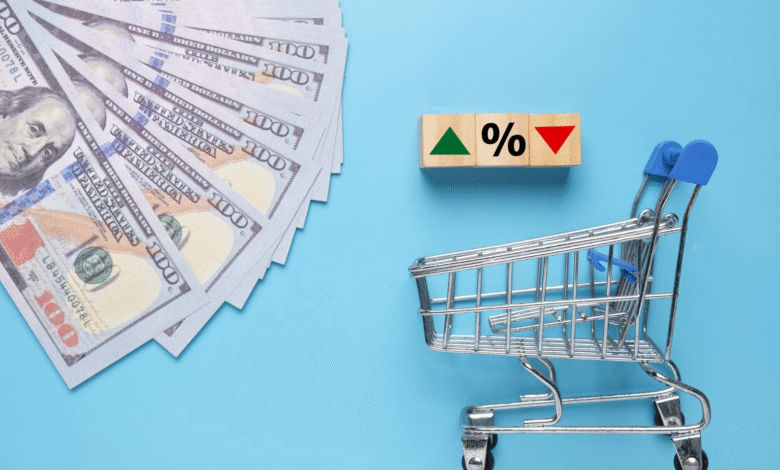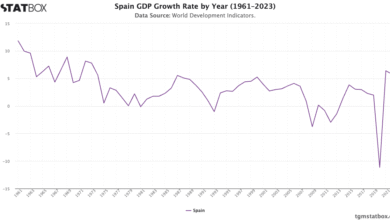May Retail Sales Decline: Consumer Spending Pulls Back

May retail sales decline marks a significant moment in the economic landscape as they fell by 0.9%—worse than the expected 0.6% decrease predicted by the Dow Jones consensus. This downturn reflects a troubling trend in consumer spending decrease, which has been spurred by a mix of rising prices and broader economic uncertainties. Despite an uptick in consumer sentiment during May, many shoppers appear hesitant to spend, particularly at auto dealerships and gas stations where sales have sharply declined. Such shifts in consumer buying patterns raise questions about the overall economic outlook as families become more selective in their purchases. In light of this decline, analysts are closely monitoring retail sales May 2025 figures to gauge potential recovery paths going forward.
The recent downturn in sales figures provides insights into changing consumer behaviors and broader market dynamics. Notably, the reduction in retail bookings is indicative of shifting priorities among shoppers, who are now more cautious about their discretionary spending. Despite some improvements seen in consumer sentiment throughout May, a consumer spending slowdown reflects deeper fears regarding economic stability and personal finances. As market analysts ponder the implications of these trends, they are increasingly focused on how external factors, including geopolitical developments and inflation, might impact future consumption patterns. This cautious consumer outlook could lead to significant ripple effects in sectors reliant on consumer purchases, altering the economic landscape for months to come.
The Decline in Retail Sales for May 2025
In May 2025, retail sales experienced a troubling decline of 0.9%, which was notably worse than the anticipated decrease of 0.6% according to the Dow Jones consensus. This unexpected dip indicates a troubling trend in consumer spending patterns, as it follows a slight decrease in April. Various industry sectors reported diminished sales, with the automobile and gas sales particularly hard hit. The downward movement in retail sales raises concerns about consumer confidence and economic stability as households become increasingly cautious in their spending habits.
Despite the overall decline, it’s important to recognize that when excluding certain categories—such as auto dealers and gas stations—the retail sales numbers actually showed a modest increase of 0.4%. This metric, often referred to as the control group, is critical for understanding the gross domestic product (GDP) dynamics. Nevertheless, the underlying factors that contributed to the 0.9% decline include rising prices and the impact of external economic factors, which have combined to influence consumer behavior negatively this month.
Consumer Spending Decrease and Its Implications
The reported decrease in consumer spending is attributed to several interrelated factors, including fluctuating gas prices and rising concerns about the overall economic outlook. Indeed, the Commerce Department’s report highlights that consumers are tightening their purses, reflecting uncertainty in their financial situations. This decrease in spending not only affects immediate retail sales figures but also poses potential risks to economic growth projections, particularly as GDP had shown signs of recovery with a forecasted growth rate of 3.8% for the second quarter.
Consumer sentiment did show some improvements in May, suggesting that shoppers are somewhat optimistic; however, this enthusiasm did not translate into increased spending. Economists note that while consumer sentiment readings improved, they remain far from the levels seen in previous years. As consumers prioritize discounts and are more selective with their expenditures, retailers are challenged to entice shoppers. Therefore, understanding consumer behavior during this time is crucial for anticipating future retail sales trends and adjusting economic forecasts accordingly.
Impact of Economic Outlook on Consumer Behavior and Retail Sales
The shifting economic outlook continues to play a pivotal role in shaping consumer behavior. Many consumers are expressing anxiety over rising prices, tariffs, and geopolitical tensions, which have led to hesitation in making substantial purchases. In the face of decreased retail sales, families are increasingly looking for good deals before committing to spending. This trend indicates a cautious approach among consumers, suggesting that the anticipated economic recovery could face headwinds if consumer confidence does not strengthen.
Furthermore, as inflationary pressures surface alongside a fluctuating job market, consumers’ preparedness to spend may diminish further. Retailers must therefore adapt their strategies, potentially focusing on discounts and promotional offers to draw in wary shoppers. The delicate interplay between economic indicators—such as consumer sentiment in May and retail sales figures—will continue to influence both business strategies and overall economic health as we move through 2025.
Analyzing the Dow Jones Consensus
The divergence between actual retail sales figures and the Dow Jones consensus highlights the challenges faced by analysts in predicting consumer behavior and economic performance. Market anticipations were set on a less severe decline of 0.6%, making the 0.9% drop a significant surprise to many key players in the financial sector. This situation underscores the complexities involved in forecasting economic trends, especially during volatile times influenced by international trade dynamics and domestic consumer confidence.
Moreover, the Dow Jones consensus serves as a reference point for investors, impacting stock market performance and overall investment decisions. Following the report, stock market futures showed a negative trend, reflecting market participants’ concerns regarding the slowing retail sector. Such reactions reveal how retail sales data can ripple through the economy, affecting not only consumer sentiment but also corporate strategies and capital markets.
Driving Factors Behind Retail Sales Trends
Understanding the driving factors behind the recent retail sales trends involves a closer look at consumer behavior, economic policies, and external influences. The recent decline in energy prices, for instance, has significantly impacted spending at gas stations, contributing to the overall drop in retail sales. In much the same way, rising prices elsewhere have forced consumers to reconsider their discretionary spending, leading to a shift towards budget-friendly shopping habits.
Additionally, external factors such as trade tensions, particularly the implications of tariffs initiated by the Trump administration, have historically impacted both consumer and business optimism. These headwinds complicate forecasting efforts and create more volatility in consumer spending patterns. Retailers need to navigate this complex landscape by offering value-added services and adapting to changing consumer preferences to mitigate the effects of ongoing economic uncertainty.
The Role of Consumer Sentiment in Retail Sales
Consumer sentiment is a crucial barometer for retail sales, as it directly influences how likely individuals are to make purchases. The dichotomy between improved sentiment in May and the overall decrease in retail sales raises compelling questions about consumer priorities. Despite consumers reporting increased optimism, external pressures like inflation and job market uncertainties weigh heavily on their spending decisions.
As such, retailers need to cultivate an environment that encourages consumer spending by addressing these concerns. They might consider offering targeted promotions or loyalty programs to enhance consumer confidence and stimulate purchases. Ultimately, bridging the gap between consumer sentiment and actual spending is essential for healthy retail sales, especially in a climate characterized by economic fluctuations.
Retail Sales Projections Amid Economic Uncertainty
Looking ahead, projections for retail sales must take into consideration the broader economic landscape, which is currently marked by uncertainty. While the anticipation for a 3.8% growth in GDP suggests a potential recovery, the reality of consumer behavior indicates a more cautious landscape. The interplay between external factors, such as international trade relations and domestic issues like inflation, may continue to pose challenges that hinder robust sales growth.
To adapt, businesses may need to recalibrate their sales strategies and engage more intensively with their customers to understand their changing needs and perceptions. Given the current economic outlook, a proactive approach emphasizing consumer-centric policies could be key to reversing the trend of declining retail sales in the coming months.
Implications of Falling Gas Sales on Retail
The notable decline in gas sales has had significant ramifications for the overall retail sales outlook. With gas station receipts dropping by 2%, this decline is indicative not only of lower energy prices but also reflects the broader consumer sentiment towards spending in other sectors. Such declines in one of the key areas of consumer spending can have a cascading effect on related industries, potentially reducing overall retail activity.
As families tighten their budgets and focus on essentials, retailers outside of the gas station sector must work harder to capture consumer interest and encourage spending. By offering promotions and emphasizing value, these retailers can work to counterbalance the negative effects of falling gas sales on their overall performance, keeping their businesses sustainable amidst challenging economic circumstances.
Conclusion on Retail Trends and Consumer Behavior
The retail landscape in May 2025 signifies a critical moment of adjustment as businesses, consumers, and economists analyze recent trends in retail sales and consumer behavior. The overall decrease in sales, despite early signs of optimism, highlights the complexities facing the economy. It serves as a stark reminder for retailers and policymakers alike of the unpredictable nature of consumer spending in uncertain economic times.
Moving forward, a comprehensive strategy that takes consumer sentiment, spending patterns, and economic outlook into account will be fundamental. By fostering a dialogue with consumers and adapting to their needs, businesses can better equip themselves to navigate future challenges, ultimately benefiting the broader economic environment in the long term.
Frequently Asked Questions
What were the main reasons for the May retail sales decline in 2025?
The May retail sales decline of 0.9% was primarily driven by a significant drop in consumer spending due to falling gas sales and ongoing concerns about the economic outlook. This decrease exceeded the Dow Jones consensus estimate of a 0.6% decline, highlighting consumer hesitation amidst geopolitical tensions and rising prices.
How does the May retail sales decline affect the economic outlook for 2025?
The May retail sales decline suggests caution among consumers, which could negatively impact the overall economic outlook for 2025. Despite an expected GDP recovery of 3.8% in the second quarter, the decline in consumer spending indicates that families are more selective about their purchases, influenced by external factors such as tariffs.
What impact did consumer sentiment have on the May retail sales decline?
Despite an improvement in consumer sentiment reported in May, retail sales still experienced a 0.9% decline. This paradox indicates that while consumers might feel more positive, worries about rising prices and economic uncertainty are leading to more cautious spending behaviors.
How significant is the May retail sales decline compared to previous months?
The 0.9% decline in May retail sales follows a 0.1% drop in April, reflecting a troubling trend in consumer spending. This downward trajectory highlights ongoing struggles in the retail sector, particularly as consumers adjust their spending habits in response to economic conditions.
What sectors were most affected by the May retail sales decline?
The retail sales decline in May significantly impacted sectors like automobile sales, which dropped by 3.5%, and building materials, down 2.7%. Gas sales also decreased by 2% due to lowering energy prices, demonstrating a widespread pullback in consumer purchases across various categories.
Could the retail sales decline in May influence stock market trends?
Yes, the May retail sales decline could influence stock market trends negatively. Following the report, stock market futures remained down, reflecting investor concerns about consumer spending and its potential effects on economic growth.
What consumer behavior trends contributed to the May retail sales decline?
Consumer behavior trends contributing to the May retail sales decline include increased price sensitivity and a focus on finding discounts. Shoppers appear to be more selective, willing to spend only when they find favorable deals amidst rising costs and economic uncertainty.
How does the decline in May retail sales compare to year-over-year trends?
Despite the month-to-month decline of 0.9% in May, retail sales are still up 3.3% compared to the same month last year. This annual comparison indicates some resilience in the retail sector, although the recent decline raises concerns about future spending.
What insights can be drawn from the May retail sales decline for the rest of 2025?
The May retail sales decline signals potential challenges for the remainder of 2025, emphasizing the need for businesses to adapt to changing consumer behaviors. With ongoing concerns about tariffs and economic conditions, retailers may need to offer more competitive pricing and focus on enhancing consumer confidence.
How can understanding the May retail sales decline inform future business strategies?
Understanding the factors behind the May retail sales decline can help businesses refine their strategies by targeting consumer sentiment and spending tendencies. Adapting to economic conditions by adjusting inventory, pricing, and marketing strategies can help retailers better meet the shifting demands of cautious consumers.
| Key Points | Details |
|---|---|
| Retail Sales Decline | Retail sales fell by 0.9% in May, surpassing the expected 0.6% drop. |
| Exclusion of Certain Categories | Excluding auto dealers and gas stations, sales rose by 0.4%. |
| Consumer Sentiment | Consumer sentiment reportedly improved despite the sales drop. |
| Sector Declines | Sales of motor vehicles down 3.5%; building materials down 2.7%. |
| Overall Sales Trend | Despite falling sales, year-over-year sales up by 3.3%. |
| Market Reaction | Stock market futures turned negative following the report. |
| Future Economic Outlook | GDP estimated to grow at 3.8% in Q2 despite the sales decline. |
Summary
The May retail sales decline reveals consumer hesitance in spending, with sales dropping 0.9%, worse than expected. This trend highlights underlying economic challenges as consumers remain cautious amid geopolitical tensions and tariff concerns. Although sentiment improved, spending patterns indicate a selective approach, reinforcing the need for retailers to strategize effectively in a shifting economic landscape.



